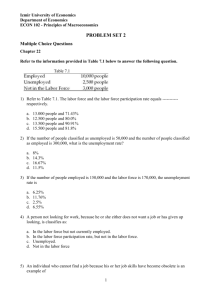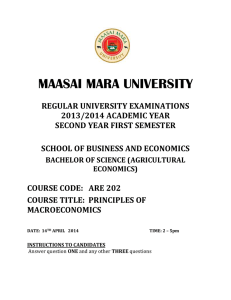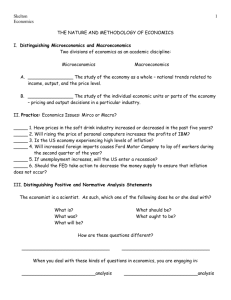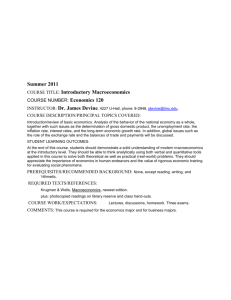roblem Set 2 - Answers
advertisement
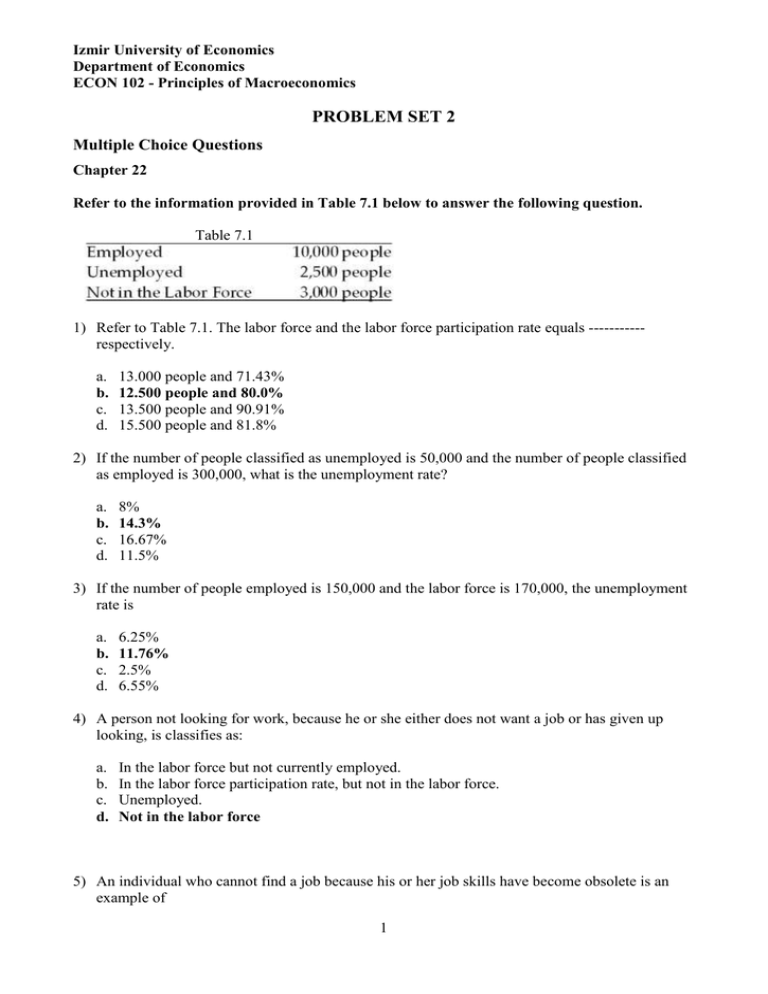
Izmir University of Economics Department of Economics ECON 102 - Principles of Macroeconomics PROBLEM SET 2 Multiple Choice Questions Chapter 22 Refer to the information provided in Table 7.1 below to answer the following question. Table 7.1 1) Refer to Table 7.1. The labor force and the labor force participation rate equals ----------respectively. a. b. c. d. 13.000 people and 71.43% 12.500 people and 80.0% 13.500 people and 90.91% 15.500 people and 81.8% 2) If the number of people classified as unemployed is 50,000 and the number of people classified as employed is 300,000, what is the unemployment rate? a. b. c. d. 8% 14.3% 16.67% 11.5% 3) If the number of people employed is 150,000 and the labor force is 170,000, the unemployment rate is a. b. c. d. 6.25% 11.76% 2.5% 6.55% 4) A person not looking for work, because he or she either does not want a job or has given up looking, is classifies as: a. b. c. d. In the labor force but not currently employed. In the labor force participation rate, but not in the labor force. Unemployed. Not in the labor force 5) An individual who cannot find a job because his or her job skills have become obsolete is an example of 1 Izmir University of Economics Department of Economics ECON 102 - Principles of Macroeconomics a. b. c. d. Frictional unemployment Structural unemployment Cyclical unemployment Seasonal unemployment 6) Which of the following is included in the economist’s definition of inflation? a. b. c. d. An increase in the price of one good. An increase in the overall price level over a significant period of time. A onetime increase in the overall price level. All of the above. 7) Which of the following indexes are used to measure the overall price level? a. b. c. d. Consumer Price Index (CPI) Producer Price Index (PPI) GDP Deflator All of the above 8) A price index is a. b. c. d. a measurement showing how the average price of a bundle of goods changes over time. a measurement showing the cost of a bundle of goods at a point in time. a sustained increase in the overall price level. a decrease in the overall price level. 9) The difference between the interest rate on a loan and the inflation rate is the a. b. c. d. Nominal interest rate. Inflation premium. Real interest rate. Expected interest rate. 10) Higher labor productivity can be attributed to: a. b. c. d. An increase in the quality of labor. An increase in the quality of capital. An increase in capital per worker. All of the above 11) Per capita output will not grow if: a. The population is not growing. b. The growth rate of output per person increases. c. Output growth is exactly keeping up with population growth. d. Both the population and output are growing. 2 Izmir University of Economics Department of Economics ECON 102 - Principles of Macroeconomics Chapter 23 1) Which of the following factors can be counted as the determinants of aggregate consumption? a. b. c. d. e. Household income Household wealth Interest rates Household’s expectations about future. All of the above Refer to the graph below for the following two questions. 2) If the individual has no current income a. b. c. d. Consumption would be zero Saving is equal to 1000 Consumption is equal to 1000 Consumption cannot be predicted 3) The marginal propensity to consume (MPC) and marginal propensity to save (MPS) out of disposable income above are ------------ respectively. a. b. c. d. 0.5 and 0.5 0.6 and 0.4 0.3 and 0.7 0.8 and 0.2. 4) In macroeconomics, equilibrium is defined as the point at which a. b. c. d. saving equals consumption. planned aggregate expenditure equals aggregate output. planned aggregate expenditure equals consumption. aggregate output equals consumption minus investment. 3 Izmir University of Economics Department of Economics ECON 102 - Principles of Macroeconomics 5) If aggregate output is greater than planned spending, then a. b. c. d. unplanned inventory investment is zero. unplanned inventory investment is negative. unplanned inventory investment is positive. actual investment equals planned investment. Refer to the figure below for the following two questions 6) What is equilibrium level of output in this economy? a. b. c. d. 200 500 800 None of the above 7) When aggregate output equals $800 billion, which of the following happens? a. b. c. d. Unplanned inventory is falling, and output will tend to rise Unplanned inventory is falling, and output will tend to fall Unplanned inventory is rising, and output will tend to rise Unplanned inventory is rising, and output will tend to fall 8) The saving/investment approach suggests that an economy is in equilibrium when, a. b. c. d. C=S S=I C=I None of the above 9) The ratio of the change in the equilibrium level of output to a change in some autonomous variable is the a. elasticity coefficient. 4 Izmir University of Economics Department of Economics ECON 102 - Principles of Macroeconomics b. multiplier. c. automatic stabilizer. d. marginal propensity of the autonomous variable. 10) Assume that AE=100+0.75Y. What is the value of the multiplier? a. b. c. d. 0.75 2 4 10 Essay Questions for Chapter 22 1) Suppose that Ahmet has just graduated from university and looking for a job. However, as a first-time job seeker he lacks the sufficient knowledge for finding the company that has the job that is available and suitable for him. Thus, he is currently unemployed. What kind of unemployment is described in the above scenario? Frictional unemployment: The proportion of unemployment due to the normal working of the labor market; used to denote short-run job/skill matching problems. 2) Contrary to expectations the unemployment rate may decrease during recessions. How can you explain this situation? It is due to the discouraged-worker effect. During recessions, people who want to work but cannot find jobs become discouraged and stop looking for a job, thus drop out of the ranks of the unemployed and the labor force. Hence, the unemployment rate declines. Essay Questions for Chapter 23 1) Consider the following model of the economy. Y = AE AE = C + I C = 300 + (2/3) Y I = 400 Where Y is the real income (output), AE is the aggregate expenditure, C is the real consumption, and I is the real investment. a. Provide a brief explanation of each of the variables of the model. 5 Izmir University of Economics Department of Economics ECON 102 - Principles of Macroeconomics b. Calculate the equilibrium level of income. Show your work and explain your answer with a graphical illustration. Y = AE Y = AE = 300 + 2/3 Y + 400 Y = 2100 c. Now suppose that investment rises to 450. What will be the new level of output in equilibrium? 2250 Multiplier = 1 1 = =3 1 2/3 1 MPC ∆Y = 450 – 400 = 50 50*3 = 150 Y* = 2100 + 150 = 2250 6
